
Fisher Models 1/32 Sea Fury
| KIT #: | ? |
| PRICE: | $195.00 MSRP |
| DECALS: | Six options |
| REVIEWER: | Tom Cleaver |
| NOTES: | Resin |

| HISTORY |
Had the Hawker Sea Fury arrived on the scene one year earlier than it did, its place in history would not be assured by its technical excellence but rather by the outstanding combat record it would undoubtedly have achieved with the British Pacific Fleet in the final struggles of 1945. As it is, the Sea Fury ‑ designed for air superiority ‑ is known for shooting down only one opponent, a MiG‑15 on August 2, 1952, by Lt. Peter "Hoagy" Carmichael of 802 Squadron. Given that, in the intervening five years between its appearance in squadron strength and that day in 1952' technological development had rendered the Sea Fury obsolete, its victory over the MiG-15 is even more remarkable. Regardless, the Sea Fury is the penultimate result of Sir Sidney Camm's philosophy of piston‑engine fighter design.
The Sea Fury began life in 1942 with a request by the Air Ministry that Hawker Aircraft design a long‑range fighter for operations in the Far East. While a radial‑engine version of the Tempest was under development at the time, it was thought that the relatively high wing‑loading of the Tempest would be ill‑suited for combat with the lightly‑loaded Japanese fighters, and thus the Sea Fury started out as the "Tempest Light Fighter (Centaurus)."
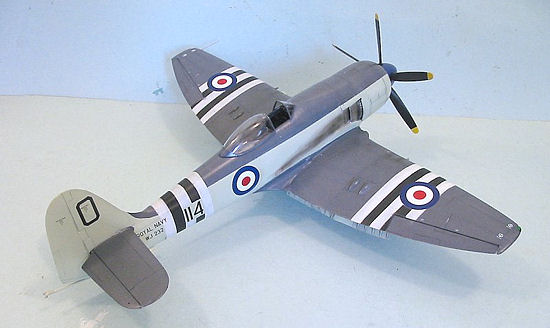 In early 1943, the designers
were directed to adapt the fighter for shipboard operation as well as the
land‑based role.
In early 1943, the designers
were directed to adapt the fighter for shipboard operation as well as the
land‑based role.
The first RAF prototype flew in September 1944, while the first navalized prototype flew in February 1945. Tests revealed a need for an increase in vertical fin and rudder size to counter the swing on take‑off, while the rigid engine mounts created difficulty until they were replaced with dynafocal‑base mounts which completely eliminated the vibration at lower speeds that had hampered the airplane's ability to land aboard ship.
While the Royal Navy was testing both the Meteor and theVampire and had ordered the Supermarine Attacker, there wassufficient doubt about the ability of jets to operate off carriers that ‑ while the RAF canceled the land‑based Fury in the face of the arrival of the new jets ‑ the Royal Navy continued to develop the Sea Fury as a shipboard interceptor and later as a fighter‑bomber. With carrier compatibility trials completed in 1947, 807 Squadron was the first to convert to the aircraft, followed by 802, 803 and 805 Squadrons between August 1947 and February 1948. The initial Sea Fury Mk.X was quickly replaced by the F.B.11, which could carry underwing drop tanks, bombs and rockets; squadrons began to equip with it in May 1948.
The Sea Fury's introduction to combat came in the fall of 1950 when 807 Squadron, operating from HMS "Theseus," joined Task Force 95, the Korean blockade force. Operating jointly with Firefly F.R.IV and V strike aircraft, FAA Sea Furies flew from HMS "Triumph," "Theseus," "Glory," and "Ocean," as well as with the RAN from HMAS "Sydney" until the end of the war in July 1953.
In typical
operations, the carrier was "on line" for 11 days ‑ 4 days of operations
followed by 3 days of replenishment followed by a final 4 days of operations; at
least two missions per day were flown by each operational aircraft aboard.
These were missions in support of ground troops, or against rail and road
transport to choke off supplies to the Chinese and North Koreans. As 802
Squadron pilot Peter Carmichael remembered, “Our biggest worry was flak. It
kept you worried the whole time. Some of it was
 radar-controlled, and some used
tracer. Most AA weapons were very well concealed, sometimes in houses in the
villages. False targets were used as flak traps and their fire discipline was
excellent.”
radar-controlled, and some used
tracer. Most AA weapons were very well concealed, sometimes in houses in the
villages. False targets were used as flak traps and their fire discipline was
excellent.”
HMS "Ocean" came on‑line in May, 1952, with 802 Squadron equipped with Sea Furies. The carrier and its group would set records during this tour. 892 Squadron was launched with 1,000-lb bombs, twice the load carried by other Sea Furies in the light wind conditions found in the East China Sea, and several daily-launch records would be set.
By July and August, enemy jet incursions over North Korea to intercept UN fighter‑bomber sorties began to increase. On August 2, 1952, eight MiG‑15s hit the mixed strike force of Sea Furies and Fireflies. Combat was sharp, with one Firefly destroyed by a MiG's heavy cannon fire, but one of the MiGs lost speed as it maneuvered around for a second attack. With throttles “through the gate” to chase this slower MiG, the Sea Furies managed to hit both it and its wingman who came back for support. One of the two crashed, and Lt. Peter "Hoagy" Carmichael, Blue Section leader, was credited with the kill, the only victory by a piston engine fighter over a jet in the war. The following day saw 8 more MiGs come after the Sea Furies, who were able to save themselves by dint of using their superior maneuverability at what was a low speed for the jets, pulling tight high-G maneuvers and taking advantage of cloud cover. One MiG was claimed damaged.
Following the end of the Korean War, the Sea Fury was rapidly replaced by its successor, the Hawker Sea Hawk, and became the primary aircraft assigned to the RNVR "weekend warrior" squadrons.
The Sea Fury was also used by the Royal Australian Navy, the Royal Canadian Navy, the Royal Netherlands Navy, the Pakistani Air Force, the Iraqi Air Force and the Cuban Air Force; it last saw combat when flown by Cuban pilots of the FAR against the Cuban exile invasion attempt at the Bay of Pigs in April 1961.
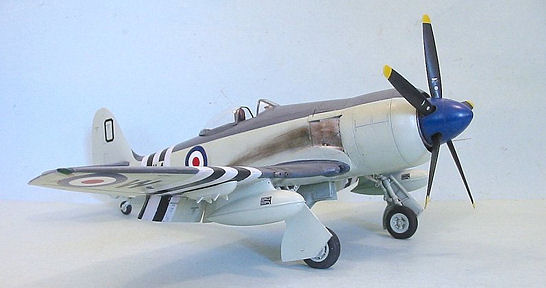 In the mid 1960s,
ex‑Canadian Sea Furies began appearing in the U.S. civil aviation fleet, and the
airplane has made a name for itself as an air racer in the years following.
While the Centaurus‑powered Sea Fury was never really competitive with the
Mustang and Bearcat in the short‑distance pylon races at Reno, the reliability
of the engine at high revs over long periods saw Sea Furies dominate long
distance races like the California 1000.
In the mid 1960s,
ex‑Canadian Sea Furies began appearing in the U.S. civil aviation fleet, and the
airplane has made a name for itself as an air racer in the years following.
While the Centaurus‑powered Sea Fury was never really competitive with the
Mustang and Bearcat in the short‑distance pylon races at Reno, the reliability
of the engine at high revs over long periods saw Sea Furies dominate long
distance races like the California 1000.
When the airplane was modified to accept the R‑4360 four‑row "corncob," and the R-3350, it became a real competitor at Reno, with several highly-modified Sea Furies among the top contenders in the Unlimited Class nowadays.
To me, there are few airplanes that look or sound better going overhead at an altitude of 100 feet or so than a Sea Fury powered by the Centaurus engine. 25 years ago, I got a ride in the jump seat of Lloyd Hamilton’s Sea Fury on a trip around the pylons for an article I was writing about the Reno Air Races that still ranks as one of the most memorable airplane rides I have ever taken.
| THE KIT |
As I say, I have been a fan of the Sea Fury for a long time. I first built the old Frog 1/72 kit in 1969, and did several more of those during the 1970s. In 1986 I discovered the Falcon 1/48 vacuform kit and did two of those, and have likely done 10-15 of the Hobbycraft kits after it was released in 1988. When Paul Fisher told me last year he was going to do a Sea Fury it was all I could do to explode. When I saw the test shot this past April, I knew it was going to be a winner.
On opening the box, the first thing anyone familiar with Paul’s kits will note is that this is much more complex than the Panther or the Cougars. Quality of the resin casting is outstanding as usual.
The
design of the kit is based on extensive research done with the Sea Fury restored
by Ellsworth Getchell and flown by him
 over the past 30 years. Since
this is one of the best, most original restorations of a Sea Fury in existence,
the resulting accuracy of the kit is superb. I know for a fact the markings are
right because Ellsworth was working on this airplane - one of the Iraqi Sea
Furies brought into the country in 1974 - at John Herlihy’s hangar at Half Moon
Bay airport when I was working on Gary Harris’ restoration of the F4U-7 BuNo
133722, and I provided Ellsworth with the information.
over the past 30 years. Since
this is one of the best, most original restorations of a Sea Fury in existence,
the resulting accuracy of the kit is superb. I know for a fact the markings are
right because Ellsworth was working on this airplane - one of the Iraqi Sea
Furies brought into the country in 1974 - at John Herlihy’s hangar at Half Moon
Bay airport when I was working on Gary Harris’ restoration of the F4U-7 BuNo
133722, and I provided Ellsworth with the information.
With a fully-detailed cockpit and the gear well and landing gear designed by Roy Sutherland - whose Cooper Details resin set did so much to improve the old Hobbycraft kit - this kit has it all. Full-detailed flaps are provided to allow the kit to be finished with flaps lowered, as well as full wing fold detail to allow the kit to be done with the wings up. There is a full engine, not just a face plate. Two 500-lb bombs and six rocket projectiles constitute the under wing armament.
Those who elect to do a Korean Fury should know that you should be sure to check what period of the war the model is supposed to have operated in, since that will affect the ordnance load. The 802 Squadron airplane flown by Peter Carmichael would have bombs only, while the 801 Squadron airplane could be armed with either two bombs or four rockets (with rockets more likely), with drop tanks in both cases. Sea Furies in Korea carried either bombs or rockets, never both, and usually never more than four rockets on any strike mission due to weight considerations.
The superb decal sheet was designed by Jennings Heilig and provides markings for six aircraft. There are two Fleet Air Arm Korean War airplanes, the de rigeur Peter Carmichael airplane from 802 Squadron aboard HMS Ocean in May-September 1952, and an 801 Squadron airplane aboard HMS Glory during her second tour in April-June 1952 (this latter are also the markings of the Sea Fury restored by Ellsworth Getchell in the 1970s). The two Royal Canadian Navy Sea Furies come in early and late camouflage and markings. The Royal Australian Navy Sea Fury is the well-known overall dark blue Sea Fury flown at Nowra in 1960, while the last is a Sea Fury F.B.50 flown by the Royal Netherlands Navy from the carrier Karel Doorman.
| CONSTRUCTION |
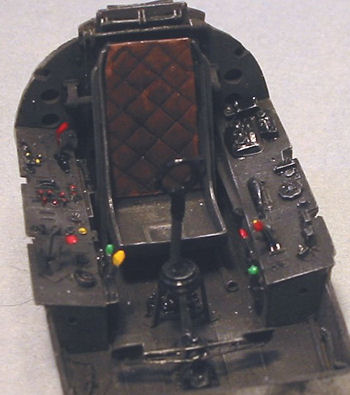 This kit is not so easy to
assemble as the previous Panther and Cougars, but it will not present any
problem to any modeler who has built at least one or two complete resin kits.
For those who are familiar with the previous kits, this one also differs because
of a different kind of resin being used in production, which shrinks laterally -
which is different from the other - and has the result that some parts have
shrunk in ways that would not be expected. Other than perhaps needing more
cyanoacrylate glue and additional Mr. Surfacer, this does not present any really
difficult problems to solve.
This kit is not so easy to
assemble as the previous Panther and Cougars, but it will not present any
problem to any modeler who has built at least one or two complete resin kits.
For those who are familiar with the previous kits, this one also differs because
of a different kind of resin being used in production, which shrinks laterally -
which is different from the other - and has the result that some parts have
shrunk in ways that would not be expected. Other than perhaps needing more
cyanoacrylate glue and additional Mr. Surfacer, this does not present any really
difficult problems to solve.
I started with the wings. Since I planned to drop the flaps, I cut them out of the lower wing part first. I assembled the wheel well and attached it to the lower wing part, then attached that to the upper wing. There was a considerable gap on the lower wing surface, which I filled with some Evergreen strip and cyanoacrylate glue. When this was dry, I gave the area a thick coat of Mr. Surfacer 500, which covered all the seams.
 I next turned to the
cockpit. It’s a pity this has to end up being painted black and displayed only
through the small hole of the fuselage cutout, because it is a kit in itself.
Anyone who has ever built a Roy Sutherland cockpit knows that he will go to the
max, putting in things that - unfortunately - cannot be seen once everything is
assembled, painted and installed in the fuselage, since he operates on the
theory of “I know it’s there.” There will be quite a bit of that with this
cockpit, but even so it is pretty simple to assemble due to excellent design. I
tried to deal with the problem of the color by painting it with Tamiya “NATO
Black” then going over it with dark grey to highlight things. I remember
sitting in Ormond Haydon-Baillie’s Sea Fury at Reno in 1972, and remarking to
myself how worn the stock cockpit in his airplane looked, and that it had
“greyed out.” I also drybrushed various areas with flat aluminum paint to
simulate wear, and then added as much color for gears and dials and such. I
simulated the leather padding on the seat by painting it with Xtracylix “Signal
Braun,” which I then hand-painted with Tamiya “smoke” to pop out detail and
simulate wear.
I next turned to the
cockpit. It’s a pity this has to end up being painted black and displayed only
through the small hole of the fuselage cutout, because it is a kit in itself.
Anyone who has ever built a Roy Sutherland cockpit knows that he will go to the
max, putting in things that - unfortunately - cannot be seen once everything is
assembled, painted and installed in the fuselage, since he operates on the
theory of “I know it’s there.” There will be quite a bit of that with this
cockpit, but even so it is pretty simple to assemble due to excellent design. I
tried to deal with the problem of the color by painting it with Tamiya “NATO
Black” then going over it with dark grey to highlight things. I remember
sitting in Ormond Haydon-Baillie’s Sea Fury at Reno in 1972, and remarking to
myself how worn the stock cockpit in his airplane looked, and that it had
“greyed out.” I also drybrushed various areas with flat aluminum paint to
simulate wear, and then added as much color for gears and dials and such. I
simulated the leather padding on the seat by painting it with Xtracylix “Signal
Braun,” which I then hand-painted with Tamiya “smoke” to pop out detail and
simulate wear.
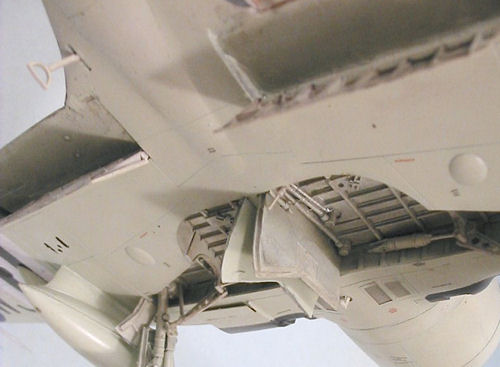 When it came time to fit the
cockpit into the fuselage, I found that the tabs meant to insure proper fit of
fuselage to wing got in the way. I cut them off, which widened that area
without creating any difficulty when it came to attaching the wing and
fuselage.
When it came time to fit the
cockpit into the fuselage, I found that the tabs meant to insure proper fit of
fuselage to wing got in the way. I cut them off, which widened that area
without creating any difficulty when it came to attaching the wing and
fuselage.
I painted the engine and installed it in the cowling, then attached the exhausts. I also inserted the exhaust flaps in the fuselage after I had installed the cockpit.
The wing, fuselage and cowling all fit fine, though there was a need to use Mr. Surfacer to fill gaps in the attachment areas. I also attached the horizontal stabilizers, elevators and rudder.
Once all that was sanded and rescribed as necessary, I decided to attach the drop tanks, since I had found through test-fitting that there was a gap between the pylon and the wing surface that would have to be filled. As it turned out, this was a mistake, and the way to fix that is to cut off the attachment pins on the drop tank, sand that area down so it fits right to the wing, then make new attachment pins.
The reason you should not attach the tanks before painting is that will limit your options. I had originally planned to do the 801 Squadron airplane from HMS Glory, since it’s the markings of the Sea Fury my old friend Ellsworth Getchell owns. But the Sea Furies in Korea all had their “D-Day stripes” in different locations, and in this case they would have been right through the area where the drop tank attaches, which would have meant I had to do a “mask-around” which is really too difficult to do. It is also a good idea not to attach the drop tanks at this time because it makes it more difficult to attach the landing gear and gear doors later. So do it the way I say here, set it to be a “drop fit” once painted, and then put the tanks aside until the end of the process.
I attached the windscreen and masked it, and it was time to proceed to the paint shop.
| COLORS & MARKINGS |
Painting:
Many people have thought over the years that the ID stripes on Royal Navy aircraft during the Korean War were all standard, like they were at D-Day, and too many “hex-spurtz” have claimed they were 18 inches wide, like they were then. Not so! They varied in width, from 10-16 inches, from squadron to squadron and perhaps airplane to airplane. The only way you can really get this right is to be working from a photo of the particular airplane you are going to do. Figure out where the stripes are in relation to panel lines and various “geographic landmarks” on the airframe, figure out that area on the model, and divide by 5. Since I had decided to do the Carmichael airplane, I was able to figure out that the stripes were 10 inches wide (5/16" in scale).
 I first painted the prop
tips flat yellow, then masked them off. I “pre-shaded” the airplane with flat
black, and also painted the areas where the stripes would be overall flat black.
I also painted the prop blades flat black.
I first painted the prop
tips flat yellow, then masked them off. I “pre-shaded” the airplane with flat
black, and also painted the areas where the stripes would be overall flat black.
I also painted the prop blades flat black.
I then masked off the black stripes, and painted the white stripes with thinned Tamiya Flat White. Doing this over black means the stripes will be “distressed,” which is the way they would have looked by the middle of the squadron’s tour with HMS Ocean in August 1952, when the famous MiG dogfight took place.
I
also painted the prop spinner white in preparation for painting it blue. There
have, over the years, been a controversy over the question of whether
Carmichael’s airplane really had this marking. On the one hand, he was Blue
Flight leader, so the color would be right if it had been used. On the other
hand, Royal Navy regs frowned on such non-standard items, and no other FAA
Squadron has been thought of to have done such a thing. There are few photos
available, and in black and white a dark blue spinner or a spinner painted Extra
Dark Sea Grey would both have a similar tonal value, so there is now way of
deciding with photographic evidence. There is, however (at least to me), a
further argument that can be made in favor of the non-standard spinner color,
and that is that the commanding officer of HMS Ocean managed to get his units to
out-do everyone else during their tour and set an overall Royal Navy record for
sorties flown and ordnance expended, with several other records for daily high
sortie rate, etc. Accomplishing that takes high morale on the part of the
ship’s crew and the aircrews, to “go the extra mile.” Those who haven’t been in
the military may think it strange, but little things like allowing
individualized spinner colors and such will go a long way to pushing unit morale
to a high point by emphasizing uniqueness and specialness. Thus, having flight
commanders with flight colors on their spinners and such would be perfectly “in
character” for 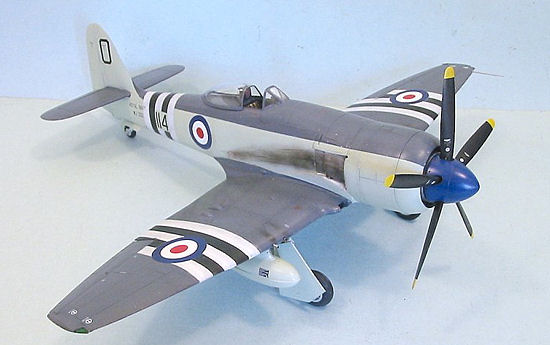 such a ship and its
air group. It would be proof if one could find a photo of the Yellow Flight
leader’s Sea Fury, since that would tonally be a different shade from Blue, Red,
or Extra Dark Sea Grey in black-and-white. In the end, it’s an educated guess,
and besides - that blue spinner just looks better. I used Xtracrylix RLM24
“Blue” on this.
such a ship and its
air group. It would be proof if one could find a photo of the Yellow Flight
leader’s Sea Fury, since that would tonally be a different shade from Blue, Red,
or Extra Dark Sea Grey in black-and-white. In the end, it’s an educated guess,
and besides - that blue spinner just looks better. I used Xtracrylix RLM24
“Blue” on this.
After masking off all the stripes, I painted the upper surfaces Xtracrylix Extra Dark Sea Grey. I then lightened the color with some Dark Sea Grey and went over the panels to “post shade” the surfaces. When that had set overnight, I masked off the upper surfaces and painted the lower surfaces with Xtracrylix “Sky,” which I also lightened with white and “post shaded” the areas.
I then hand-painted the wheel well, the landing gear, the wheel hubs, and the inside of the gear doors with thinned Tamiya “Smoke” to simulate oil stains and wear.
When all was dry, I unmasked the model and gave it a coat of Xtracrylix Gloss Varnish.
Decals:
The kit decals were designed by Jennings Heilig and printed by Cartagraph. They are excellent, and go on without any problem. The only difficulty was that the instructions do not give full information on placement of the stenciling, so for the larger items you match shapes, and for the smaller items you are left guessing. I doubt there are many experts out there who will be able to point out any deficiencies or mistakes. Paul promises to put up a page on his website with the corrected information, that you can download and print out to aid you with your model.
| FINAL CONSTRUCTION |
 I decided to do this model
of the airplane as it might have looked shortly after landing back aboard HMS
Ocean from Carmichael’s famous dogfight with the MiGs. Since he had “put it
through the gate” in the course of that fight, the normally-clean Centaurus
would have smoked and left some severe residue. I have seen this on Centaurus-powered
Sea Furies at Reno back in the 1970s. It’s oily and glossy, and easily cleaned
off once things cool down, but it looks pretty awesomely-cruddy right after
shutdown. I accomplished this by hand painting some thin
I decided to do this model
of the airplane as it might have looked shortly after landing back aboard HMS
Ocean from Carmichael’s famous dogfight with the MiGs. Since he had “put it
through the gate” in the course of that fight, the normally-clean Centaurus
would have smoked and left some severe residue. I have seen this on Centaurus-powered
Sea Furies at Reno back in the 1970s. It’s oily and glossy, and easily cleaned
off once things cool down, but it looks pretty awesomely-cruddy right after
shutdown. I accomplished this by hand painting some thin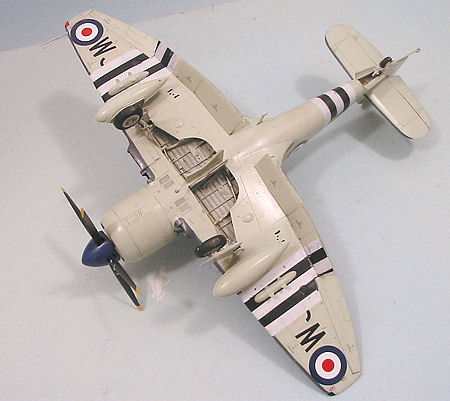 ned
Tamiya “Smoke,” which I then airbrushed over.
ned
Tamiya “Smoke,” which I then airbrushed over.
I then assembled the spinner and prop, unmasked the windshield and canopy and posed it in the open position, and attached the landing gear. I am glad the gear is in brass, because this model is heavy and anything less would eventually succumb to weight and gravity.
| CONCLUSIONS |
If you love the Sea Fury, this is the definitive kit of this airplane. For those who ask, is it worth $195, I will say it is a bargain at that price for what is there and what can be created. A modeler of average ability should be able to create a show-stopper with this kit, built OOB. For someone who wants to super-detail what is there, the result would be a serious “Nats contender.”
If you want a kit that is top-quality, for which an excellent outcome is virtually guaranteed, Paul Fisher’s Sea Fury is the one you want.
October 2006
Review kit courtesy Fisher Model Products.
Copyright ModelingMadness.com. All rights reserved. No reproduction in any form without express permission from the editor.
If you would like your product reviewed fairly and fairly quickly, please contact the editor or see other details in the Note to Contributors.